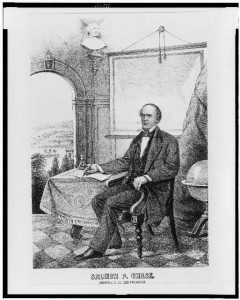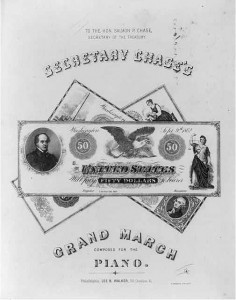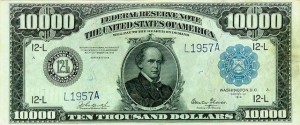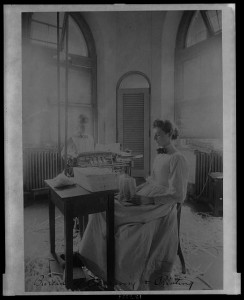And on his currency, too
From The New-York Times October 6, 1861:
The Financial Victories of Mr. Chase.
Correspondence of the Baltimore Clipper.
WASHINGTON, D.C., Tuesday, Oct. 1, 1861.
When, before the organization of the present Administration, it was understood that GOV. CHASE, Senator elect from Ohio, had been selected by President LINCOLN for the Treasury, and that he had consented to undertake the arduous and important charge, there were not a few presses and persons found expressing the opinion that an error in policy was about to be consummated, and that the right man was not in the right place. It was contended that Gov. CHASE was more peculiarly fitted and calculated for the Department of State, if, indeed, he should be taken at all for any position among the constitutional advisers of the Executive. Voila tout! The assertion is here ventured that no more able, capable, astute or successful statesman than Gov. CHASE has ever been in charge of the most necessary and important Department of the Executive branch of our Government. Nor is it too much, perhaps, to say, that few men, known to fame, could have conducted the difficult and stupendous monetary negotiations of these perilous and troublous times with so great and gratifying success as SALMON P. CHASE has done. The country, the solid men the men of money, both among us and abroad, have implicit confidence in the judgment, prudence, discretion and sagacity of Gov. CHASE, and are now ready to confess that how well soever his peculiar talents may fit him for the diplomatic duties of the State Department, he is equally, if not better calculated to conduct, control and manage the great laboratory whence must come not only the [???] of war, but the motive and enabling power of the Government itself. In fact, his administration of the fiscal operations of the times has made him hosts of friends.
During Salmon P. Chase’s stint as Secretary of the Treasury (1861-64)
there were two great changes in American financial policy, the establishment of a national banking system and the issue of paper currency. The former was Chase’s own particular measure. He suggested the idea, worked out the important principles and many of the details, and induced the Congress to approve them. It not only secured an immediate market for government bonds, but also provided a permanent uniform, stable national currency. Chase ensured that the Union could sell debt to pay for the war effort. He worked with Jay Cooke & Company to successfully manage the sale of $500 million in government war bonds (known as 5/20s) in 1862.
The first U.S. federal currency, the greenback demand note, was printed in 1861-1862, during Chase’s tenure as Secretary of the Treasury. These greenbacks formed the basis for today’s paper currency. It was Chase’s responsibility to design the notes. In an effort to further his political career, his face appeared on a variety of U.S. paper currency, starting with the $1 bill so that the people would recognize him.
Perhaps Chase’s chief defect was an insatiable desire for high office. Throughout his term as Treasury Secretary, Chase exploited his position to build up political support for another run at the Presidency in 1864.
He also tried to pressure Lincoln by repeatedly threatening resignation, which he knew would cause Lincoln difficulties with the Radical Republicans.
To honor Chase for introducing the modern system of banknotes, he was depicted on the $10,000 bill printed from 1928 [1918?] to 1946. Chase was instrumental in placing the phrase “In God We Trust” on United States coins.
Chase was indeed a rival on the Team of Rivals
You can see an example of the $1 notes with Chase’s self-promoting image at The Kennedy Mint
*** 10-07-2011: Salmon on the Spot as in the sense of Johnny on the Spot – the editorial thought Chase was just what the Treasury Department needed.




